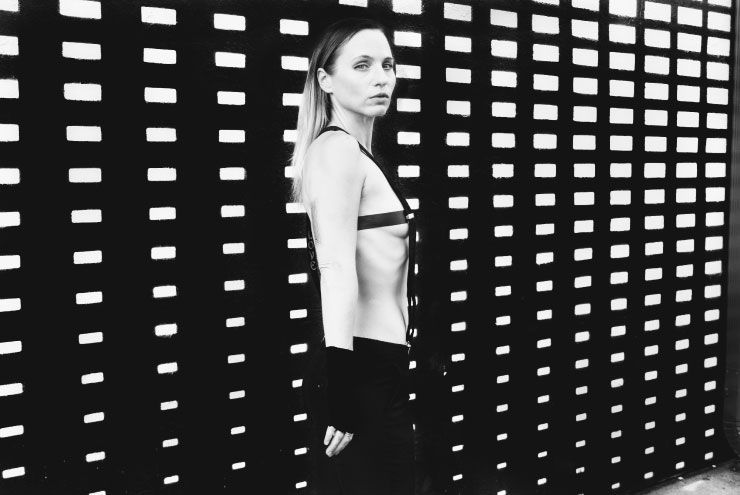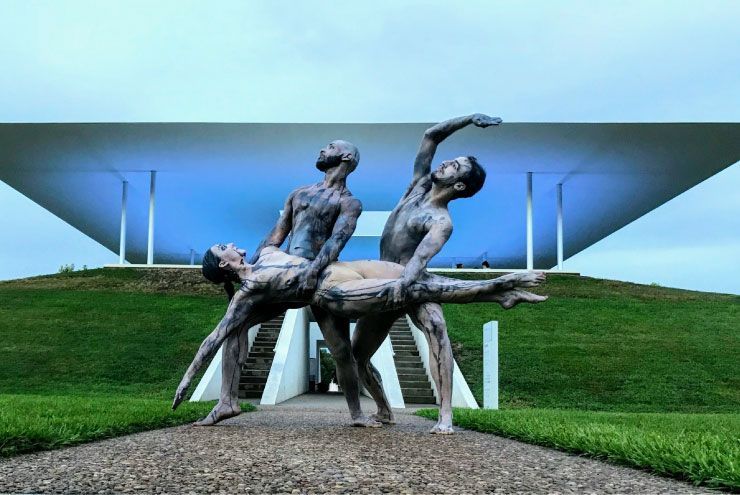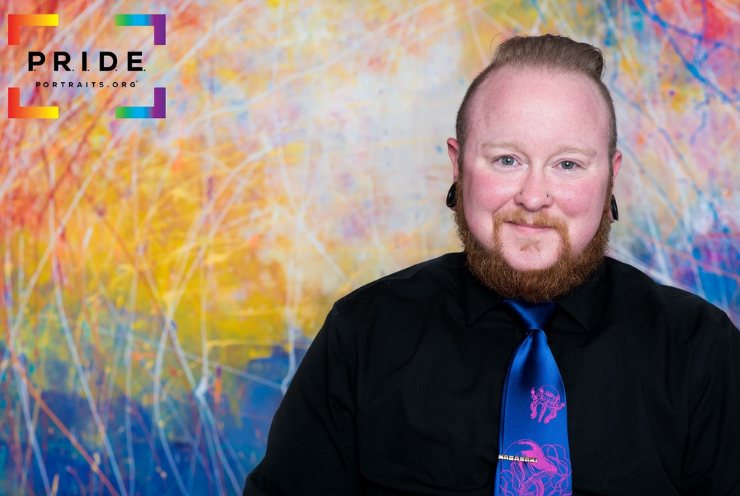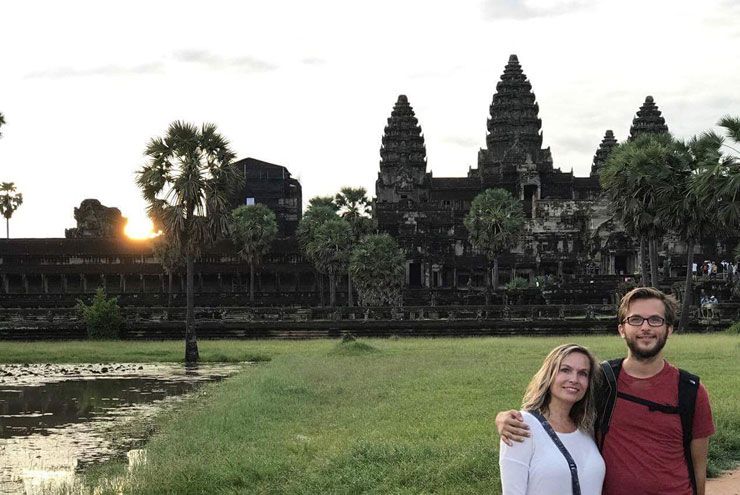By Rebecca French
Step 1: Ballet is broken.
I recently attended a Choreographers’ Forum at Houston’s 2018 Dance Salad Festival. The panel consisted of two gay male choreographers and one straight female choreographer. During the question and answer portion of the evening, I stood up and asked the artists if they had choreographed any work that explored queer experience and romantic relationships. Given how common love duets are in dance, I expected at least one or both of the gay choreographers to name queer-themed works they had created. They both said they never had. One of them, a choreographer originally from Houston who has primarily worked in Europe for the past decade, went as far as to make fun of the question, saying “I haven’t figured out what my ‘gay’ ballet technique looks like yet.” He imitated doing a pirouette while circling his head wildly and said “Is it like this?” The audience laughed. I said, “I think it’s strange that an entire section of the population doesn’t see their lives represented in the dance world, and I find it disturbing that gay choreographers aren’t doing more to express their own experiences through their art form.” A woman in the audience spoke up and said, “Diaghilev made a gay male love duet back in the 1920s set to Tchaikovsky…so it’s been done.” I thought, Wow, one dance that was made a hundred years ago is supposed to be enough for us? How long do we have to wait for the next one? Rather than saying that, I replied, “It’s interesting you mention Tchaikovsky, given that he committed suicide because he couldn’t be openly gay in Russia when he was a composer. I think that highlights a problem in the art world that lingers today, and it’s time to move beyond our shameful past of silencing and punishing gays. It’s time to give us the representation we deserve.”
The crowd and panel fell silent, until the female choreographer spoke up and said that she had made a contemporary gay love dance a few years ago, and being straight didn’t stop her from wanting to explore all types of relationships onstage. As she was talking, I immediately understood the difference—she’s a modern/contemporary choreographer, and her funders and audience members are at least somewhat receptive to seeing queer expression onstage. The two men were from the ballet world, where many of the performers and choreographers are gay, but the funding all comes from donors and institutions that are deeply invested in upholding the Judeo-Christian heteropatriarchy. So as an artist, if you rock that boat, you lose all the cash. But maintaining the tired old status quo causes both artists and audiences to lose even more: innovation, relevance, authenticity and excitement. I’ll personally never forget the thrill of watching the Wachowski sisters’ show Sense8 when it first came out—seeing queer characters who were in many ways like me, who encountered similar discrimination and relationship issues I’ve experienced, as well as characters from all over the world whose lives appeared vastly different from my own. That combination of novelty and relatability are missing for me in the dance world. Sense8’s success proved that stories told only from a straight white male perspective are no longer enough for mainstream television anymore. And they’re not enough for the performing arts anymore either.
There are some limiting rules in place that have to be dismantled in order to create a new world of authentic, representative artistic expression. Choreographers and dancers (especially in the ballet world) have been taught to follow specific gender and appearance roles in performance:
- Women should only be beautiful, soft, and passive onstage, not aggressive or strong. They are lifted by men but don’t lift men.
- Men should only be strong and aggressive onstage—not beautiful, soft, or passive. They lift women but are not lifted by women.
- Gender ambivalence is not encouraged.
- All romantic attraction and love expressed must be heterosexual.
- Dancers should be thin, able-bodied, and fit into society’s accepted norms of attractiveness.
- Though dancers train and condition their bodies to express a range of profound ideas, their bodies should always be covered enough to appease the most conservative and puritanical audience members and funders.
I am a dancer, choreographer, and art consumer; I’m also a woman and gay person. I don’t see myself represented in the dance work that’s currently being made and performed. That’s a problem for me and I know I’m not alone. Fortunately, as an artist with a big voice and an unstoppable spirit, there’s a lot I can do about it.
Step 2: Who are we as a society…and what is queer dance theory?
While many dance audience members and funders are white, middle-aged or older, and identify as heterosexual, they do not reflect our current population. Numerous studies over the past several years report that the majority of the population is not exclusively heterosexual and that over half of Generation Z members (people born after 1994) identify with one or more letters in the LGBTQIAP alphabet soup (lesbian, gay, genderqueer, bisexual, bigender, transgender, trans, queer, questioning, intersex, asexual, agender, pansexual and polyamorous, among others!). Half of younger folks acknowledge that they are queer, about 35 percent of Millennials do, and between 10 to 25 percent of older adults do. But regardless of whether one declares it publicly or not, we’re all somewhere on the spectrum of sexuality and gender non-conformity. So why don’t we see the reality of our lives reflected onstage more in the performing arts?

“I am a dancer, choreographer, and art consumer; I’m also a woman and gay person. I don’t see myself represented in the dance work that’s currently being made and performed. That’s a problem for me and I know I’m not alone. Fortunately, as an artist with a big voice and an unstoppable spirit, there’s a lot I can do about it.” -Rebecca French
Buzzfeed defines queer dance as “a profound intersection of sexuality, race, and gender-nonconforming individuals defiantly living their truth in a safe, celebratory space.” Clare Croft, author of Queer Dance: Meanings and Makings takes five specific stances on what queer dance might be: “(1) that women and feminism are central to any queer project; (2) that social dance and concert dance hold equal import; (3) that, through anti-racist and anti-colonial labor, queerness must always work to challenge white privilege; (4) that queerness has to challenge the entrenchment of the gender binary; and (5) that queer dance happens across an expansive map, both global and regional.” Given these definitions, it makes absolute sense that the ballet and concert dance worlds—which in practice are committed to protecting gender norms, white privilege, and the patriarchy—see queer representation as a threat and reject it.
Fortunately, that’s not stopping many visionary artists such as choreographers Jennifer Monson, DD Dorvillier, Thomas DeFrantz, Jennifer Harge, Nic Gareiss, Post Natyam, Emma Portner, Lauren Lovette, Cleek Schrey, and many more. Locally, Jhon Stronks has been making queer dance in Houston for over a decade. Cassils, the LA-based nonbinary visual and performance artist, currently has an exhibit at the Station Museum of Contemporary Art in Houston, which includes videos of their performance art and a trans-themed display that is not to be missed.
There are now many grant-making institutions and foundations that support queer performance such as the New England Foundation for the Arts (NEFA), Guggenheim Fellowship Foundation, United States Artists, Queer|Art, MAP Fund, and Creative Capital, to name a few. This financial support is crucial. Artists in the past have had to choose between making authentically queer work or being funded, and now there are increasing opportunities for them to have both.
In addition, the author of the aforementioned Queer Dance: Meanings and Makings book, Clara Croft, also curates the EXPLODE: queer dance project, which began in Ann Arbor in 2012 and will tour nationally in 2019.
There’s no denying it: the queer dance movement is growing, and it’s one that includes all of our voices.
Step 3: Being part of the solution.
I am expanding my leadership in both the queer and dance communities by choreographing work that celebrates queer bodies and experience, such as the Bodies of Light performance coming this spring at the Turrell Skyspace, which explores gender fluidity in movement as well as same-sex love stories; and the Stonewall 50th Anniversary performance at Houston’s Contemporary Arts Museum in May 2019, which will commemorate LGBTQ history and acknowledge the contributions of our community’s leaders, both past and present.
In addition, I’m leading queer dance workshops for university students who are ready to break free from the limitations the dance world has given them. The workshop provides an in-depth exploration of queer modes of movement expression, guided body-positivity self-work, discussion on dismantling constrictive gender roles in dance, personal reflection and writing, and choreography creation and performance—all in an affirming, informational environment. It’s gratifying to see the next generation embrace these freedoms and begin to lead us all to an exciting, evolved new place in dance.
Step 4: Now it’s your turn.
So, where do you think we need more queer representation in the world? Please add your thoughts in the comments below. Also, please tell us about a recent live performance you saw that included queer themes and characters!








Sarah Gamblin
December 2, 2018 at 6:29 PMI support your overall statement but I did not see mention of Matthew Bourne’s Swan Lake from 2005- I don’t see how you can critique the lack of queer critique in ballet without mentioning this dance.
https://en.wikipedia.org/wiki/Swan_Lake_(Bourne)
Rebecca French
December 3, 2018 at 10:05 PMGreat point Sarah, and thank you for bringing that work to my attention. I don’t believe that piece has ever been performed in Houston, which is partly why I hadn’t heard about it before. My critique of the lack of queer representation in the ballet world is based primarily upon my experience living in the south. Though we have a world-class ballet company in Houston I have yet to see them perform any pieces like this.
Stephanie Sherman
December 3, 2018 at 11:50 AMI resonate deeply with this article. Thank you so much. I also think that it is important to consider what kinds of queer narratives are allowed (mainly gay maleness) and how institutionalized patriarchies shape the near absence of female and trans queerness onstage. Thank you again- I will share this article with my students and dancers!
Rebecca French
December 3, 2018 at 10:11 PMGreat points, Stephanie. We have to keep pushing to make space for our female and trans queer voices to be heard!
Stephanie Sherman
December 6, 2018 at 4:11 PM🙂 hasta la victoria siempre!!!
Rebecca French
December 16, 2018 at 7:37 PMSin lugar a duda 😍
Nazar Rakhmanov
December 16, 2018 at 7:52 AMWe need more queer representation in the places were it still not safe to be… we need a dialog specifically with people who ignorant, and for this dialog to free able to succeed – we need to respect them.
Sarah Gamblin
December 19, 2018 at 10:49 PMhttps://www.advocate.com/art/2018/12/16/dancing-queer-identity